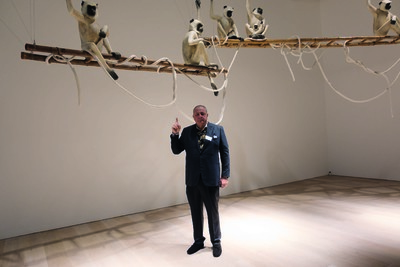Dressing for the XXXL man has always been a tight squeeze.
By Alexander Fury
Photographs by Jean Pigozzi
Dressing for the XXXL man has always been a tight squeeze.

Jean Pigozzi wearing an XXXL bespoke printed silk Moschino lounge suit, made by Jeremy Scott for this story. ‘I am on my jet ski rushing to a meeting with the king of the monkeys in a mangrove in the north of Panama.’
Back in March 2000, Belgian designer Martin Margiela (the real one) showed a bunch of pretty ordinary clothes. What made them extraordinary was their size: each had been constructed on a dress form in Italian size 74 and 78 (a US size 40 and 44, respectively; hardly your standard model measurements). It wasn’t the first time we’d seen this oversized stuff: Margiela himself had presented a collection expanded by varying percentages – 148, 150 or 200 – the previous season, with inserts of fabric sewn into some garments to distend and distort them. And in the 1980s, everything was big: big egos, big hair, big bucks, and big shoulders held up by big shoulder pads to fill the big houses those big-time arbitrageurs and corporate raiders were buying themselves. Giorgio Armani built a big business off them, and Chanel blew up around that time, too. But the 1990s were a decade of ninny clothes, skinny and lank and limp. Margiela’s blow-up ran against received wisdom and the current style. It made big big again – in every sense – except the people inside.
It’s never really gone away, that taste for expanding garments. Perhaps because it’s the perfect fashion double bluff. Making everything so large only serves to emphasize the dichotomy between the body and the garment: a skinny girl looks even skinnier in a big girl’s clothes. By the same logic, a too-tightly fitting garment will only serve to make you look heavier. It’s an optical illusion that’s become a useful fashion cliché.
At least, it has for women. But menswear? Menswear is a body fascist – and it has been for centuries. Ever since the introduction of the tailored suit – sometime around the time the 18th century turned into the 19th, after the French Revolution and in the midst of the Industrial one – suits have only suited a certain type. The ideal back then, and oddly enough, today, is the neoclassical, the nudes of Ancient Greece and Rome with their defined, muscled torsos, wide shoulders, slender hips, good legs. Wrap that up tightly in a great lump of wool, and you’ve nailed what every tailored suit is aiming for, and looks best on, even today. The perfect male, circa 500BC.
The issue is when a man’s body type sits outside those narrow confines. If you’re smaller, it’s easy. The bulk is added for you; the fashion is fashioned. That’s why tailoring was originally developed. Replacing highly decorated clothes made from soft silk – the embroidered juste-au-corps frock coat of 19th-century court dress – tailors instead crafted woollen coats with internalized structures of linings and interfacings, padding filling sunken chests and straightening sloping shoulders, jackets tightly double-breasted to hold in the stomach. Wool, naturally elastic, with qualities of compression and expansion woven into its fabric, could be treated with heat and steam to magically mould it to different dimensions, invisibly shrinking and swelling to give the impression of the idealized male body to even the skinniest of wearers. ‘Heroes in wool’ is the great phrase coined by fashion historian Anne Hollander, to reflect this third revolution, the cloth version. Psychologist J. C. Flügel called this moment when men abandoned overt embellishment and bright colours in favour of sober suiting, the ‘Great Male Renunciation’.
Ever since the introduction of tailored suits – sometime after the French Revolution and during the Industrial one – they have only suited a certain type.
But men also abandoned something more fundamental: a Renaissance template of masculine power, the idea that, when it comes to menswear, bigger is better. In the past, masculine bulk was desirable, even required. Heft was impressive. In 1520 at the Field of the Cloth of Gold, King Henry VIII of England had a 36.1-inch (size 52 in Italian) waist and 41.8-inch chest; he was aged just 28. And in 1537, his girth was not minimized, but accentuated, even exaggerated in his portrait by Hans Holbein; the shoulders of the-then 45-year-old king are vastly inflated, padded and draped with jewels, trimmed with fur and embroidery, his feet firmly planted to bear the weight. His clothes resemble a palace on his back. Over 180 years later, Hyacinthe Rigaud’s 1701 image of Louis XIV emphasizes majesty again through mass: ermine runneth over, cloaking the entire painting right to the frame, the whole subsumed by his fashion – and therefore his body.

Jean Pigozzi wearing an XXXL bespoke navy-blue, single-breasted Ermenegildo Zegna suit and Tod’s Gommino driving loafers in black suede – both made for this story – and his own shirt. ‘At the N. S. Harsha: Charming Journey exhibition at the Mori Art Museum in Tokyo.’
It was not specific to men; the rotund nude women of Rubens and Van Dyck were also full-bodied, but their corporeal fleshiness was either vulnerable or voluptuous. Centred on the belly and hips, emphasizing child-rearing qualities, this body shape was echoed in the too-familiar dress of the time, those wide-spread paniers, and all that folded satin, like quivering, gelatinous flesh. A full-figured female body wasn’t powerful, however; it was passive – sensual, sexual, and to be consumed. The heft of the male form, by contrast, was about exerting power and presence, just as those monarchs dominated the frames of their images. For men, virility and fertility were, of course, also implied, but for them, it was active, aggressive and assertive.
Despite sounding like it went out of fashion with the feudal system, it didn’t. Not really. Throughout the 20th century, bulk has crept in and out of menswear as a way to assert a degree of male dominance, particularly when threatened. The zoot suits of late 1940s African-American culture – capacious trousers and elongated ‘drape’ jackets hanging off shoulders, which Malcolm X (a zoot suiter himself) described as ‘padded like a lunatic’s cell’ – are interesting because, for all the perceived flamboyance of their colouring and fabric, they have a traditional top-heavy male silhouette, an almost Renaissance swagger. While zoot suits underline a more general easing of the male silhouette in the same period, with boxier, roomier jackets and trousers, they are also important because of who wore them. They were sported by a disenfranchised group – people who needed to express power they didn’t actually have. The XXXL had become about pretence, about the appearance of power.
That was the thinking later in the 1980s, when the look was once again revived. The extreme width of shoulders – for him, and for her – was as evocative of power in 1987 as it was in 1537. The body inside was once again bulked out, this time by the gym or steroids, but was always pushed further through the oversized clothes of Armani, and – for the creatively inclined – Yohji Yamamoto, Comme des Garçons, and Matsuda, tailors of choice to a then-oversized Karl Lagerfeld, among others. ‘When I started a men’s line in Paris, my message was very simple: let’s be outside of this,’ Yamamoto wrote, in his 2014 Rizzoli monograph Yamamoto and Yohji. ‘Let’s be far from our suits and ties. Let’s be far from businessmen. Let’s be vagabonds.’ And yet, Yamamoto’s vagabond looks weren’t that far from those businessmen’s, their sloping, eased silhouette conforming to the same sense of volume and proportion, the prevalent shape of the decade. The power exchange this time tended towards artists, rather than arbitrageurs; Jean-Michel Basquiat painted in his floppy Yamamoto suits (though he wore Armani, too).
In the mid-1990s, however, something shifted. Men began to look actively, consciously fragile; slender in themselves, their clothes were cut to emphasize the bodies within. The low waistband of trousers and high-rise of a cropped top (for him as well as her) framed the hipbones; knits clung to torsos. The man-boys of Hedi Slimane’s tenures at Yves Saint Laurent Rive Gauche in the late 1990s, and Dior Homme from 2000, set the fashion pace. They also shifted the power of their message, from assertive XL width to the streamlined and slick. Suddenly, men didn’t want to beef up, but to slim down, and exercise patterns shifted, to avoid building bulky muscle and focus instead on tone. Sizes got smaller. This was in line with the general moves in menswear since the Great Masculine Renunciation. It was a renunciation of volume, as well as decoration, away from the curve, towards the straight and narrow. It was also practical: it’s easier to create clothes that hang on a slender figure than to dart and seam them around female – or, indeed, male – curves. The architecture of slender clothes is both simpler, and more industrial, as they’re easier to mass-produce, and more economical.
Does Henry VIII’s gargantuan suit of armour from 1540-something mean the same thing as a giant Vetements puffer jacket does today?
American painter Barnett Newman once asserted that if women’s clothing is an art, men’s clothing is a sculpture. What he meant, I think, is that womenswear by and large establishes its silhouette for the moment (the crinoline, the mini-skirt, even the 1980s power suit) and tinkers on the surface of things to affect change. Or, rather, its impression. By contrast, changes in menswear are made in three dimensions. It’s more difficult to change menswear, and the transformations tend to be sweeping exercises in volume, reducing or expanding, each with nuanced meaning.
Today, there’s another change afoot. Menswear is expanding again; a typically perverse reaction to a decade defined by slimming suiting, and a natural result of period of socio-economic uncertainty. (Using more fabric is a sure-fire way to bulk up your prices, as well as your garments – more cloth costs more, even if people are buying fewer pieces. That’s why women’s hemlines almost always drop during a recession.) But I keep being drawn back to those notions of power, and power exchange, and wondering if the bulked-up clothes we’re showing today say the same things as those of the distant past. Is the masculine role static enough for us to say that Henry VIII’s gargantuan suit armour, with its 51-inch waist and 54.5 inch chest, from 1540-something means the same thing as a giant Vetements puffer jacket does today? If a woman was to wear a crinoline or paniers – as she might have done under the influence of Christian Lacroix couture, and possibly other expensive and difficult-to-procure substances, in the mid-1980s – we wouldn’t suggest she was anxious to emphasize her fecundity. (Even if she probably was out for a good time.) So why is a bolder-shouldered menswear silhouette still dubbed ‘power-dressing’? Why is the assumption that a man is out for a fight?

Jean Pigozzi wearing an XXXL bespoke black wool Dior Homme suit, made by Kris Van Assche, and his own shirt. ‘Pain au chocolat for breakfast with Cary Leitzes at The Shilla Hotel in Seoul, South Korea.’
Perhaps it is because the viewer is, nearly invariably, presumed to be a man. Those aforementioned images of fragile men are generally dubbed homoerotic, immediately assumed to be images of men made to be consumed by men. No such assumption, oddly, is made of female images, even when included in a fashion magazine with a predominantly female readership. So a man in wide-cut shoulders is presenting himself as powerful for other men, not for himself – and, perhaps, not even for women, whom it’s assumed he’s aiming to impress, if we’re reducing it all down to Captain Caveman logic of fighting and fucking.
But the voluminous men’s clothes we’re seeing emerge today, in the 21st century, have eschewed all these traditional connotations. More often than not, they more reveal the fragility of the men wearing them, rather than hiding it. We’re not duped into believing the wearers have grown their girth themselves, like Henry VIII; they’re not powerful figures, but rather reduced to something child-like (not childish, a different thing). There’s a vulnerability to, say, Rick Owens’ men wrapped in down-stuffed coats, or Balenciaga’s XXXL boxy tailoring contrasting with skinny trousers, or wide pants balancing tightly wrapped torsos. We see the weakness inside. Today, the jig is up. Power today is embedded in the clothes – the bigger the coat, the bigger and more powerful the fashion statement, the image, you’re projecting. Clothes no longer make the man; instead, it’s the man who makes the clothes that has become all important. It’s no longer about trying to convince an observer you’re a big man; rather, that you’re wearing a big brand.
